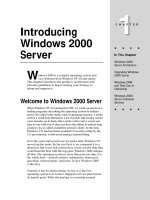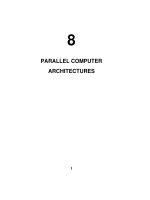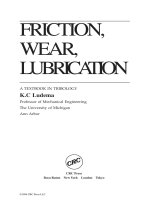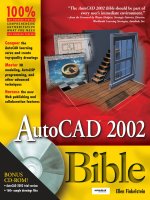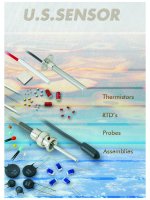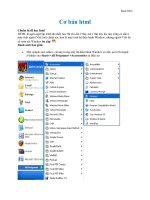Tài liệu Parallel Port Complete- P1 doc
Bạn đang xem bản rút gọn của tài liệu. Xem và tải ngay bản đầy đủ của tài liệu tại đây (216.23 KB, 20 trang )
Parallel Port
Complete
Programming, Interfacing,
& Using the PC's
Parallel Printer
Port
I
NCLUDES
DISK
r
I
ncludes EPP ECP
I
EEE-1284
r
Source code i n
Visual Basic
r
User tips
Jan Axelson
Please purchase PDF Split-Merge on www.verypdf.com to remove this watermark.
Table of Contents
I
ntroduction ix
1
Essentials 1
Parallel Port Complete
Defining the Port 1
Port Types
System Resources 4
Addressing
Interrupts
DMA Channels
Finding Existing Ports
Configuring 6
Port Options
Drivers
Adding a Port
Port Hardware 9
Connectors
The Circuits Inside
Cables
Multiple Uses for One Port 11
Security Keys
Alternatives to the Parallel Port 13
Serial Interfaces
Please purchase PDF Split-Merge on www.verypdf.com to remove this watermark.
Other Parallel Interfaces
Custom I/O
Cards
PC Cards
2
Accessing Ports 17
The Signals 17
Centronics Roots
Naming Conventions
The Data Register
The Status Register
The Control Register
Bidirectional Ports
Addressing 24
Finding Ports
Direct Port 1/O 26
Programming in Basic
Other Programming Languages
Other Ways to Access Ports 31
LPT Access in Visual Basic
Windows API Calls
DOS and BIOS Interrupts
3
Programming Issues 39
Options for Device Drivers 39
Simple Application Routines
DOS Drivers
Windows Drivers
Custom Controls
Speed 45
Hardware Limits
Software Limits
4
Programming Tools 53
Routines for Port Access 53
Data Port Access
Status Port Access
Control Port Access
Bit Operations
A Form Template 60
Saving Initialization Data
Finding, Selecting, and Testing Ports
5
Experiments 85
Viewing and Controlling the Bits 85
Circuits for Testing
Output Types
Component Substitutions
i
v
Parallel Port Complete
Please purchase PDF Split-Merge on www.verypdf.com to remove this watermark.
Cables & Connectors for Experimenting 99
Making an Older Port Bidirectional 100
Cautions
The Circuits
The Changes
6
I
nterfacing
105
Parallel Port Complete
Port Variations 105
Drivers and Receivers
Level 1 Devices
Level 2 devices
Interfacing Guidelines 110
General Design
Port Design
Cable Choices 112
Connectors
Cable Types
Ground Returns
36-wire Cables
Reducing Interference
Line Terminations
Transmitting over Long Distances
Port-powered Circuits 124
When to Use Port Power
Abilities and Limits
Examples
7
Output Applications
129
Output Expansion 129
Switching Power to a Load 132
Choosing a Switch
Logic Outputs
Bipolar Transistors
MOSFETs
High-side Switches
Solid-state Relays
Electromagnetic Relays
Controlling the Bits
X-10 Switches
Signal Switches 143
Simple CMOS Switch
Controlling a Switch Matrix
Displays 148
8
I
nput Applications
149
Reading a Byte 149
v
Please purchase PDF Split-Merge on www.verypdf.com to remove this watermark.
9
Synchronous Serial Links 165
10
Real-time Control
183
Periodic Triggers 183
11
Modes for Data Transfer 203
Vi
Latching the Status Inputs
Latched Input Using Status and Control Bits
5 Bytes of Input
Using the Data Port for Input
Reading Analog Signals 154
Sensor Basics
Simple On/Off Measurements
Level Detecting
Reading an Analog-to-digital Converter
Sensor Interfaces
Signal Conditioning
Minimizing Noise
Using a Sample and Hold
About Serial Interfaces 165
A Digital Thermometer 166
Using the DS 1620
The Interface
An Application
Other Serial Chips
Simple Timer Control
Time-of-day Triggers
Loop Timers
Triggering on External Signals 189
Polling
Hardware Interrupts
Multiple Interrupt Sources
Port Variations
The IEEE 1284 Standard 203
Definitions
Communication modes
Detecting Port Types 207
Using the New Modes
Port Detecting in Software
Disabling the Advanced Modes
Negotiating a Mode 210
Protocol
Controller Chips 212
Host Chips
Peripheral Chips
Peripheral Daisy Chains
Parallel Port Complete
15
E
Parallel
Please purchase PDF Split-Merge on www.verypdf.com to remove this watermark.
12
Compatibility and Nibble Modes 223
13
Byte Mode 249
14
Enhanced Parallel Port: EPP 267
15
Extended Capabilities Port:
ECP
Parallel Port Complete
Programming Options 220
Compatibility Mode 223
Handshaking
Variations
Nibble Mode 228
Handshaking
Making a Byte from Two Nibbles
A Compatibility & Nibble-mode Application 232
About the 82C55 PPI
Compatibility and Nibble-mode Interface
Handshaking 249
Applications 250
Compatibility & Byte Mode
Compatibility, Nibble & Byte Mode with Negotiating
Inside the EPP 267
Two Strobes
The Registers
Handshaking 269
Four Types of Transfers
Switching Directions
Timing Considerations
EPP Variations 275
Use of nWait
Clearing Timeouts
Direction Control
An EPP Application 277
The Circuit
Programming
ECP Basics 286
The FIFO
Registers
Extended Control Register (ECR)
Internal Modes
ECP Transfers 289
Forward transfers
Reverse Transfers
Timing Considerations
Interrupt Use
285
Please purchase PDF Split-Merge on www.verypdf.com to remove this watermark.
Using the FIFO
Other ECP Modes 296
Fast Centronics
Test Mode
Configuration Mode
An ECP Application 298
16
PC-to-PC Communications 305
A PC-to-PC Cable 305
Dos and Windows Tools 306
MS-DOS's Interlnk
Direct Cable Connection
A PC-to-PC Application 311
Appendices
A
Resources 323
B
Microcontroller Circuit 327
C
Number Systems 329
I
ndex 333
viii
Parallel Port Complete
Parallel
F
h
a
0
0
P
0
u
ti
O
cl
it
w
e
P
1
I
le
Please purchase PDF Split-Merge on www.verypdf.com to remove this watermark.
I
ntroduction
I
ntroduction
From its origin as a simple printer interface, the personal computer's parallel port
has evolved into a place to plug in just about anything you might want to hook to
a computer. The parallel port is popular because it's versatile-you can use it for
output, input, or bidirectional links-and because it's available-every PC has
one.
Printers are still the most common devices connected to the port, but other popular
options include external tape and disk drives and scanners. Laptop computers may
use a parallel-port-based network interface or joystick. For special applications,
there are dozens of parallel-port devices for use in data collection, testing, and
control systems. And the parallel port is the interface of choice for many
one-of-a-kind and small-scale projects that require communications between a
computer and an external device.
In spite of its popularity, the parallel port has always been a bit of a challenge to
work with. Over the years, several variations on the original port's design have
emerged, yet there has been no single source of documentation that describes the
port in its many variations.
I
wrote this book to serve as a practical, hands-on guide to all aspects of the paral-
lel port. It covers both hardware and software, including how to design external
Parallel Port Complete
i
x
Please purchase PDF Split-Merge on www.verypdf.com to remove this watermark.

